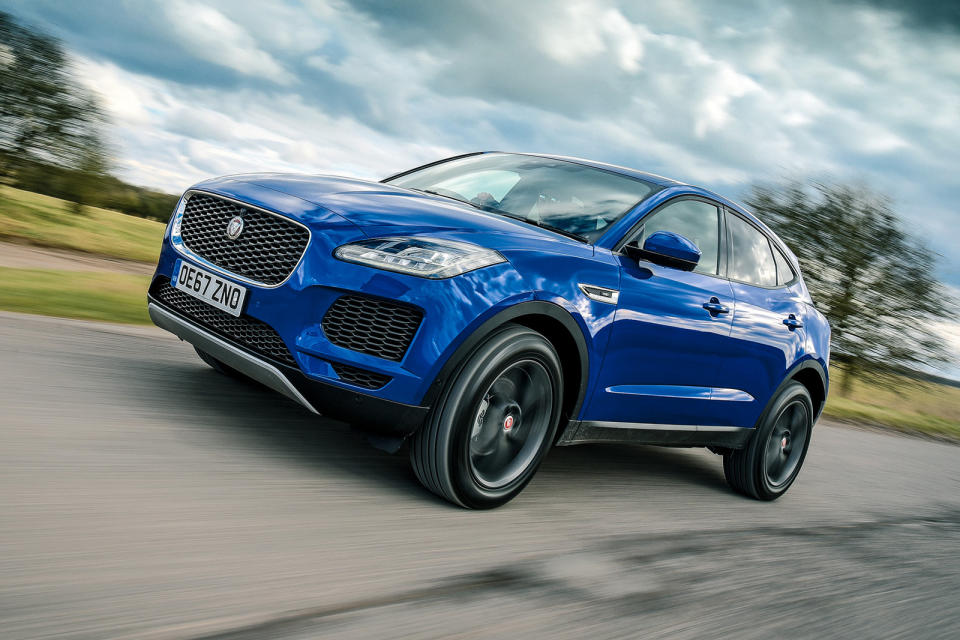Jaguar E-Pace

For an idea of the scale of ambition embodied in the new Jaguar E-Pace, consider that 80% of those who choose to buy one over, say, an Audi Q3 or BMW X1 will be new to Jaguar showrooms. ‘Conquest customers’, as they’re dispassionately known within the industry.
That’s a mighty statistic even for a car expected to supplant the Jaguar F-Pace as the brand’s bestselling model, although it is one bolstered by the fact that quite a few will be built specifically for the Chinese market in a state-of-the-art plant in Changshu.
To grease manufacturing wheels and meet anticipated demand in Europe, every other E-Pace will be assembled in Austria by Magna Steyr, the firm that has built the Mercedes-Benz G-Class since 1979 and is currently configuring its lines for the electric Jaguar I-Pace.
If all goes to plan, the E-Pace will be something of a breakthrough car for Jaguar, and one, it is hoped, that will push annual global sales past the quarter-million mark. Predictably, we’re talking about a compact SUV here, one that slots into the range beneath the F-Pace, although mechanically it has more in common with a Land Rover Discovery Sport.
Entry-level models will be front-driven, but the majority – our test car included – will benefit from an on-demand clutch-based four-wheel-drive system capable of channelling drive to both axles. And to capture that rear-driven Jaguar feel, the most powerful variants also get a GKN Driveline ‘twinster’ torque-vectoring rear differential related to the one you’ll find on the current Ford Focus RS. It only distributes up to half of available engine torque between the rear wheels, mind, rather than the 70% you get in the Ford.
Of some concern to its maker will be that the E-Pace arrives almost concurrently with our class leader of the moment, the Volvo XC40, which is competent, desirable and likeable in equally formidable measures.
With parallel values, this downsized Jaguar SUV is in some respects a British-designed and engineered XC40, so does it have what it takes to mount a convincing challenge?
Jaguar E-Pace FAQs
Is the Jaguar E-Pace available as a plug-in hybrid or electric?
The E-Pace was one of the first Jaguar’s to be available with a plug-in hybrid set-up - and the good news is that it’s rather a good one. Combining a 1.5-litre three-cylinder petrol with a well integrated electric motor, the all-wheel drive P300e delivers a combined power output of 305bhp and a 0-62mph time of 6.1 seconds, yet claims an all-electric range of up to 39 miles. If you want a fully electric Jaguar, then the larger and more expensive i-Pace is your only option.
What are the main rivals to the Jaguar E-Pace?
There’s no shortage of rivals for the Jaguar E-Pace in the hotly contested compact premium SUV class. Few are quite as engaging to drive as the Jaguar, but models such as the BMW X1 and Mercedes-Benz GLA arguably offer even more upmarket appeal, while the closely related Land Rover Discovery Sport serves-up more space and off-road ability. If you’re not fussed by an upmarket badge, then the Kia Sportage and Skoda Kodiaq deliver greater practicality and kit for a lot less cash.
How much power does the Jaguar E-Pace have?
Like many of its rivals, the Jaguar E-Pace has a choice of engine options to suit most tastes and budgets. The entry-level D165 features a 161bhp 2.0-litre diesel that’s available with front-wheel drive guise and a six-speed manual, or four-wheel drive and a nine-speed auto. This latter transmission combination is standard on the 201bhp 2.0-litre diesel D200 and the 246bhp 2.0-litre petrol P250. At the top of the range is the plug-in hybrid P300e, which delivers a hot hatch-humbling 305bhp.
What choices of gearbox are there for a Jaguar E-Pace?
A manual gearbox is an increasingly rare option in premium SUVs, but the entry-level front-wheel drive Jaguar E-Pace D165 gets a six-speed ‘box as standard. On all the other petrol and diesel models, a smooth-shifting nine-speed automatic is the only transmission available, which is mated exclusively to an electronically controlled four-wheel drive system. For the range-topping P300e plug-in hybrid there’s an eight-speed auto, plus a single speed transmission for the rear axle-mounted electric motor.
Where is the Jaguar E-Pace built?
Despite having a number of factories in the UK, Jaguar actually builds all versions of the E-Pace in two of its overseas plants. Most examples are assembled at the in Graz, Austria, at the Magna Styer facility that also produces the all-electric Jaguar i-Pace. Since 2018, the Jaguar E-Pace has also been built by Chinese partner Chery Jaguar Land Rover at the joint venture company’s factory in Changshu, China, where it also builds long wheelbase versions of the Jaguar XE and XF saloons.
How many generations of the Jaguar E-Pace have there been?
Jaguar is a relative latecomer to the SUV party, and when it launched in 2017 the E-Pace was its second ever model in this sector, following on from the larger F-Pace. As a result, the current car is the first generation model, although it was facelifted in late 2020, gaining a subtly refreshed looks, plus an even smarter interior with improved infotainment. It also saw the introduction of the plug-in hybrid, with its 39 mile range and claimed fuel returns of up to 201.8mpg.
]]>

 Yahoo Autos
Yahoo Autos 